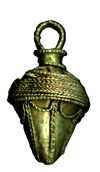A new find of a Mesolithic antler axe from western Poland
DOI:
https://doi.org/10.23858/SA/74.2022.2.2764Keywords:
antler-base axes, Mesolithic, Boreal period, Lower Silesia, microscopic analysisAbstract
In 2017, a man fishing in the Oder River accidentally discovered an antler-base axe in the village of Domaszków, Lower Silesian Voivodeship. In-depth study of the axe included analysis of the traces on its surface, radiocarbon dating and paleogenetic analysis, and concluded with the tool’s conservation. Most of the traces casting light on the techniques used in its crafting had been eroded by intensive water action. The axe was made from the unshed red deer antler. Among the preserved marks we note pointed depressions made during the separation of the antler beam, traces where the brow and bay tines were cut off, and concentric rings from the drilling of the perforation. A small scar on the axe’s blade was identified as resulting from the tool’s use. Radiocarbon dating placed the origins of the axe in Boreal period. Such tools are known from western Poland and the north-western European Mesolithic as well as from the Neolithic and the Early Bronze Age.
Downloads
References
Bagniewski Z. 1987. Niektóre zagadnienia osadnictwa mezolitycznego na terenie Polski południowozachodniej. Studia Archeologiczne 15, 3-80.
Bagniewski Z. 1990: Obozowisko mezolityczne z doliny Baryczy. Pobiel 10, woj. leszczyńskie (= Studia Archeologiczne 19). Warszawa, Wrocław: Państwowe Wydawnictwo Naukowe.
Bagniewski Z. 1992. Untersuchungsergebnisse aus der mesolitischen Torfstation Pobiel 10 (Niederschlesien). Prähistorische Zeitschrift 67/2, 141-162.
Clark J. G. D. 1975. The Earlier Stone Age settlement of Scandinavia. London: Cambridge University Press.
Cziesla E. and Pettitt P. 2003. AMS-14C-Datierungen von spätpaläolitischen und mesolitischen Funden aus dem Bützsee (Brandenburg). Archäologisches Korrespondenzblatt 33/1, 21-38.
Elliott B. 2015. Facing the chop: redefining British antler mattocks to consider larger-scale maritime networks in the early fifth millennium cal BC. European Journal of Archaeology 18, 222-244.
Fiedorczuk J. 1995. Mesolithic finds at Dudka 1, Great Masurian Lakeland, and their chronological taxonomic relations. Przegląd Archeologiczny 43, 47-59.
Gajewski L. 1969. Topór z rogu jelenia z miejscowości Zawieprzyce, pow. Lubartów. Wiadomości Archeologiczne 34/3-4, 454-455.
Goslar T., Kabaciński J., Makowiecki D., Prinke D. and Winiarska-Kabacińska M. 2006. Datowanie radiowęglowe zabytków z Kolekcji Epoki Kamienia Muzeum Archeologicznego w Poznaniu. Fontes Archaeologici Posnanienses 42, 5-25.
Gramsch B. 1973. Das Mesolithikum im Flachland zwischen Elbe und Oder. Teil I (= Veröffentlichungen des Museums für Ur- und Frühgeschichte Potsdam 7). Berlin: VEB Deutscher Verlag der Wissenschaften.
Grygiel R. 2008. Neolit i początki epoki brązu w rejonie Brześcia Kujawskiego i Osłonek, vol. II, part 2: Środkowy neolit. Grupa brzesko-kujawska kultury lendzielskiej. Łódź: Fundacja Badań Archeologicznych Imienia Profesora Konrada Jażdżewskiego.
Gumiński W. 1989. Gródek Nadbużny. Osada kultury pucharów lejkowatych. Wrocław: Zakład Narodowy im. Ossolińskich.
Ilkiewicz J. 2010. Narzędzia z poroża jeleniowatych z Pobrzeża Koszalińskiego. Materiały Zachodniopomorskie 6/7 (2009/2010), 15-42.
Jensen G. 1991. Ubrugelige økser? Forsøg med Kongemose – og Ertebøllekulturens økser af hjortetak. In B. Madsen (ed.), Eksperimentel arkæologi. No 1. Studier i teknologi og kultur. Lejre: Historisk-Arkæologisk Forsøgscenter, 9-22.
Kabaciński. J. 2009. Quarrying the antler adzes – a new Mesolithic site of the Boreal period at Krzyż Wielkopolski, western Poland. Quartär 56, 119-130.
Kabaciński J., David E., Makowiecki D., Schild R., Sobkowiak-Tabaka I. and Winiarska-Kabacińska M. 2008. Stanowisko mezolityczne z okresu borealnego w Krzyżu Wielkopolskim. Archeologia Polski 53/2, 245-290.
Kempisty A. 1958. Narzędzia z kości i rogu południowej grupy kultury pucharów lejkowatych z terenu Wyżyny Małopolskiej. Materiały Starożytne 4, 301-321.
Mathiassen T. 1948. Danske Oldsager 1: Ældre Stenalder. København: Nordisk Forlag.
Orłowska J. and Osipowicz G. 2017. Searching for the function of the Early Holocene heavy duty bevel-ended tools: remarks from experimental and use-wear studies. In A.V. Sitdikov (ed.), Kamenniy vek i nachalo epokhi rannego metalla. Tekhnologiya izgotovleniya i funktsi kostianykh izdeliy v drevnikh kulturakh Evrazii (= Arkheologiya Evraziyskikh stepey 2). Kazan: Akademia
nauk Respubliki Tatarstana, Institut archeologii im. A. H. Halikova AN RT, 103-121.
Pratsch S. 1994. Die Geweihartefakte des mesolitisch-neolitischen Fundplatzes von Friesack 4, Kr. Havelland. Veröffentlichungen des Brandenburgischen Landesmuseums für Ur- und Frühgeschichte 28, 7-98.
Riedel K., Pohlmeyer K. and von Rautenfeld D. B. 2004. An examination of Stone Age/Bronze Age adzes and axes of red dear (Cervus elaphus L.) antler from the Leine Valley, near Hannover. European Journal of Wildlife Research 50, 197-206.
Schuldt E 1961. Hohen Viecheln – ein mittelsteinzeitlicher Wohnplatz in Mecklenburg (= Deutsche Akademie der Wissenschaften zu Berlin, Schriften der Sektion für Vor- und Frühgeschichte 10). Berlin: Akademie Verlag.
Smith Ch. 1989. British antler mattocks. In C. Bonsall (ed.), The Mesolithic in Europe. Papers presented at the Third International Symposium Edinburgh 1985. Edinburgh: John Donald Publishers Ltd., 272-283.
Stefaniak K. 2015. Neogene and Quaternary Cervidae from Poland. Kraków: Institute of Systematics and Evolution of Animals Polish Academy of Sciences.
Downloads
Published
How to Cite
Issue
Section
License
Copyright (c) 2021 Sprawozdania Archeologiczne

This work is licensed under a Creative Commons Attribution-NonCommercial-NoDerivatives 4.0 International License.














